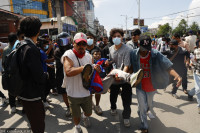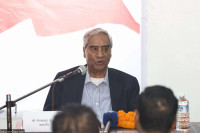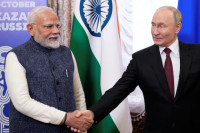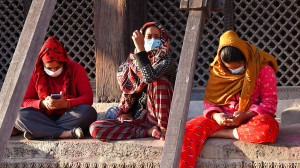Opinion
Money matters
Migrant workers need to be informed about the best ways to use and invest remittance
Bikram Manandhar
Foreign labour migration has emerged as an alternative livelihood opportunity for Nepali youths due to a lack of adequate domestic employment opportunities and globalisation. Over time, labour migration from Nepal has extended from India to countries in the Southeast and Fareast Asia, to the Gulf and to Africa. According to the Department of Labour and Employment, there has been a steady increase in the total number of labour permits issued for foreign employment. A total of 2,226,152 permits were issued over a six-year period, a 137 percent increase between 2008/09 and 2013/14, which represents about eight percent of Nepal’s population. Assessing the real number of labour migrant is largely impossible, due to the open border with India and migrants’ use of irregular channels. Everyday, around 1500 Nepalis youth leave the country for foreign employment from Tribhuvan International Airport. This figure could be much higher if exit through other ways are also included.
One of the basic motives of overseas labour migration is to remit a portion of earnings to the family. Since migrant leave their families behind, they have a strong bond with the countries of origin and maintain regular contact through remittances. As a result of rapidly increasing migrant population, the country has been higher amount of remittances from these migrant workers. They send home Rs 1.5 billion on an average each day contributing to over 29 percent of Nepal’s GDP. In addition to this formal channel, there is a large share of money transferred through hundi—transfer of money without the prior approval of the central bank. According to the 2011 Nepal Living Standard Survey, 56 percent of Nepali households receive remittance. Remittances have thus become a significant source of income across the country. Increasing the flow of remittances has emerged as a favoured poverty alleviation strategy in Nepal which witnessed a 18 percent decline in absolute poverty in the six years between 2003/04 and 2009/10. Thus, this study was conducted to assess the current process of labour migration and remittance utilisation.
From Jhapa to Korea
Information was collected through questionnaires and survey among migrant workers in South Korea, originally from Jhapa. Among those surveyed, 96 percent of the migrant workers were male and four percent were female. According to the EPS Korea Section, a total of 25,216 labourers have migrated to South Korea since 2008 of which only 1531 are female. Sixty-seven percent of the migrants are below 30 years of age; 63 percent of them are married and 37 percent are single. Migrant workers in South Korea come from families than can manage to find money for foreign employment, among them 45 percent managed to pay for current employment from family and personal savings. Though the government has fixed a service charge of around Rs 90,000 for facilitating foreign employment in Korea more than 38 percent of the migrants had to invest above Rs 100,000 to pursue their current employment.
Most had migrated without consulting anyone on safe migration. Among those who did consult, they mostly talked to friends and another migrants. Very few approached government offices. Mostly, it is educated youths that migrate to South Korea. More than 75 percent of the respondents had an academic qualification above higher secondary level (10+2). Likewise, 63 percent of them were engaged in a profession where they did not require any specific skill. Most of them (67 percent) had been in foreign employment for the first time; among them 75 percent were in their current employment for more than one to two years.
One of the main motives for labour migration is remittance. Most use informal channels (57 percent) and bank (40 percent) to remit. More than 40 percent of the respondents remit once a month where as more than 65 percent remit Rs 50,000-150,000 at a time. Remittances sent home in the last 12 months is to invest in construction (17 percent) food (14 percent); education (seven percent); 37 percent of the remit money is saved by their family; six percent is spent on consumable goods and 19 percent is invested on agriculture, health, business, etc. More than 92 percent of migrant workers are very to moderately involved in the decision-making process of remittance utilisation whereas 40 percent make the final decision on how to spend the money sent home. The study showed that fathers are the first choice for migrants to send money to followed by their spouse and mother as the second and third choice respectively.
Ways to invest
Labour migration for foreign employment is one of the major sources of income of Nepali households and will remain so for the next few decades. Its contribution to the national economy is well established even though the issue of making labour migration process hassle free has not received due attention. A great deal of migration is currently taking place for unskilled jobs. This has also been a hindrance acquiring greater benefits from migration unlike other migrant-driven countries that export skilled workers.
So the government should facilitate skilled labour migration and job placements according to their academic and vocational training. It is urgent to offer migrant workers proper counselling on safe labour migration processes. Workers should also get vocational trainings and be educated on financial literacy and productive remittance utilisation. Currently, there is no policy environment for the utilisation of earned capital and acquired skills once a migrant returns home. Thus, migrant workers are investing remittance on an ad hoc basis. The Labour Bank announced by the government is a significant move towards creating a favourable environment for utilising earned capital and acquired skills for contributing to economic growth of Nepal. But work on it has not progressed as expected. Information about it needs to be widely disseminated among migrant workers. Only then, can Nepal can observe more positive impacts of foreign labour migration, in terms of both remittance and skills, which can contribute to Nepal’s development ultimately stopping the next generation from being forced migrate for survival.
Manandhar is a research officer and consultant with Practical Action. This article is a part of research project, ‘Understanding the role of remittances in reducing risk to earthquakes’, conducted by Practical Action in partnership with the Nepal Risk Reduction Consortium




 14.12°C Kathmandu
14.12°C Kathmandu








%20(1).jpg&w=300&height=200)

